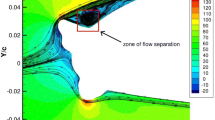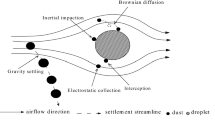Abstract
Research on the water droplet motion and impact on surface is the basis of aircraft icing prediction and design of ice protection system. First, a new computational method based on statistical theory was developed in the Euler–Lagrange framework to calculate the local water impingement coefficient on the surface, which could be used to study the effect of turbulent dispersion on the water droplet motion and impingement characteristics. Second, based on the RANS model for the air flow field, taking engine cone surface with or without slot as examples, the influence of turbulent dispersion on the water impingement coefficient on the surface was comparatively analyzed with the discrete random walk model. For the cone without film slot, turbulence causes a little impact on water droplet impingement. However, for the slotted cone, water droplet collection calculation must consider the effect of turbulence due to the stronger turbulence induced by the jet air. Further studies show that the effect is enhanced with the decrease of water droplet diameter. Finally, discussion about turbulent effects was proposed. This research about the influence of turbulent dispersion will be helpful to improve the accuracy of the water droplet impingement calculation for some complex geometries.









Similar content being viewed by others
References
Kind RJ, Potapczuk MG, Feo A et al (1998) Experimental and computational simulation of in-flight icing phenomena. Progress Aerosp Sci 34(5–6):257–345
Da Silveira RA, Maliska CR, Estivam DA et al (2003) Evaluation of collection efficiency methods for icing analysis. In: Proceedings of 17th international congress of mechanical engineering, Sao Paulo
Bourgauh Y, Boutanios Z, Habashi WG (2000) Three-dimensional Eulerian approach to droplet impingement simulation using FENSAP-ICE, Part 1: model, algorithm, and validation. J Aircr 37(1):95–103
Yi X, Wang K, Gui Y et al (2010) Study on Eulerian method for icing collection efficiency computation and its application. Acta Aerodyn Sin 28(5):596–601
Wu M, Chang S, Leng M et al (2014) Simulation of droplet impingement characteristics of spinner based on Eulerian method. J Beijing Univ Aeronaut Astronaut 40(9):1263–1267
Shen X, Lin G, Yang S (2011) Analysis on three dimensional water droplets impingement characteristics of engine inlet. J Beijing Univ Aeronaut Astronaut 37(1):1–5
Ke P, Wang X (2011) Improvements in numerical analysis of droplet impingement using Lagrangian approach. SAE 2011 international conference on aircraft and engine icing and ground deicing, Chicago, IL, USA
Wright WB, Potapczuk MG, Levinson LH (2008) Comparison of Lewice and Glennice in the SLD Regime. AIAA J
Hedde T, Guffond D (1995) Onera Three-dimensional icing model. AIAA J 33(6):1038–1045
Ke P, Zhang S, Wu J et al (2009) An improved known vicinity algorithm based on geometry test for particle localization in arbitrary grid. J Comput Phys 228(24):9001–9019
Ke P, Wang X (2011) Super-cooled large droplets consideration in the droplet impingement simulation for aircraft icing. Procedia Eng 17:151–159
Yang H, Ke P, Yang C (2016) Analysis of droplet impingement characteristics of aero-engine nose cone with hot air film. ASME Turbo Expo 2016
Wright WB (1995) Users manual for the improved NASA Lewis ice accretion code LEWICE 1.6
Hedde T, Guffond D (2013) Improvement of the ONERA 3D icing code, comparison with 3D experimental shapes. Int J Fluid Mech Res 40(5):391–404
Gent RW (1990) TRAJICE2—a combined water droplet and ice accretion prediction code for airfoils. Royal Aerospace Establishment, Farnborough, Hampshire TR No. 90054
Mingione G, Brandi V (1996) A code for the evaluation of ice accretion on multi-element airfoils. CIRA TN-96-089
Bourgault Y, Habashi WG, Dompierre J et al (1999) A finite element method study of Eulerian droplets impingement models. Int J Numer Meth Fluids 29(4):429–449
Morency F, Beaugendre H, Habashi WG (2003) FENSAP-ICE: a study of effects of ice shapes on droplets impingement. AIAA J 2003:1223
Hua F, Hang Y, Zhong K (2017) Influence of turbulent effect on the collection process of aerosols by raindrops. China Environ Sci 37(1):13–20
Hamed A, Das K, Basu D (2005) Numerical simulations of ice droplet trajectories and collection efficiency on aero-engine rotating machinery. 43rd AIAA aerospace sciences meeting and exhibit
Das K, Hamed A, Basu D (2006) Ice shape prediction for turbofan rotating blades. AIAA 2006-0209
Nathman J, Mccomas A (2007) Icing collection efficiency from direct simulation. 45th AIAA aerospace sciences meeting and exhibit, Reno, Nevada
Han Y, Ke P, Yang C et al (2013) Research on particle statistic method of water droplet impingement characteristics. Hangkong Xuebao Acta Aeronaut Astronaut Sin 34(7):1588–1595
Bidwell CS (2015) A Lagrangian parcel based mixing plane method for calculating water based mixed phase particle flows in turbo-machinery. Comput Part Mech 2(1):39–50
Wirogo S, Srirambhatla S (2003) An Eulerian method to calculate the collection efficiency on two and three dimensional bodies. 41st aerospace sciences meeting and exhibit, Reno, Nevada
Ruff GA, Berkowitz BM (1990) Users manual for the NASA Lewis Ice Accretion Prediction Code (LEWICE)
Boutanios Z (1999) An Eulerian 3D analysis of water droplets impingement on a Convair-580 nose and cockpit geometry. Mechanical and industrial engineering
Bidwell CS, Mohler SR (1995) Collection efficiency and ice accretion calculations for a sphere, a swept MS (1)-317 wing, a swept NACA-0012 wing tip, an axisymmetric inlet, and a Boeing 737–300 inlet. 33rd aerospace sciences meeting and exhibit, Reno, NV, USA
Papadakis M, Rachman A, Wong SC et al (2004) Water impingement experiments on a NACA 23012 airfoil with simulated glaze ice shapes. 42nd AIAA aerospace sciences meeting and exhibit, Reno, Nevada
Kwak JY, Cho H, Chun TY et al (2015) Domain decomposition approach applied for two- and three-dimensional problems via direct solution methodology. Int J Aeronaut Sp Sci 16(2):177–189
Acknowledgements
Thanks for the funding from the National Natural Science Foundation of China (Grant no. 51706244).
Author information
Authors and Affiliations
Corresponding author
Additional information
An earlier version of this paper was presented at APISAT 2017, Seoul, Korea, in October 2017.
Rights and permissions
About this article
Cite this article
Peng, K., Xing, T., Yi, L. et al. Effects of Turbulent Dispersion on Water Droplet Impingement Based on Statistics Method. Int. J. Aeronaut. Space Sci. 19, 330–339 (2018). https://doi.org/10.1007/s42405-018-0040-4
Received:
Revised:
Accepted:
Published:
Issue Date:
DOI: https://doi.org/10.1007/s42405-018-0040-4




